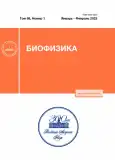Therapeutic effects of high-dose inhaled nitric oxide gas against post-covid syndrome, diabetes or AIDS
- 作者: Vanin A.F1, Pekshev A.V2, Pechyonkin E.V3, Vagapov A.B2, Sharapov N.A2
-
隶属关系:
- N.N. Semenov Federal Research Center for Chemical Physics
- N.E. Bauman Moscow State Technical University
- Stavropol State Medical University
- 期: 卷 68, 编号 1 (2023)
- 页面: 142-149
- 栏目: Articles
- URL: https://journals.rcsi.science/0006-3029/article/view/144414
- DOI: https://doi.org/10.31857/S0006302923010167
- EDN: https://elibrary.ru/OBGWMC
- ID: 144414
如何引用文章
全文:
详细
作者简介
A. Vanin
N.N. Semenov Federal Research Center for Chemical Physics
Email: vanin.dnic@gmail.com
Moscow, Russia
A. Pekshev
N.E. Bauman Moscow State Technical UniversityMoscow, Russia
E. Pechyonkin
Stavropol State Medical UniversityStavropol, Russia
A. Vagapov
N.E. Bauman Moscow State Technical UniversityMoscow, Russia
N. Sharapov
N.E. Bauman Moscow State Technical UniversityMoscow, Russia
参考
- А. В. Шиповалов, А. Ф. Ванин, О. В. Пьянков и др., Биофизика, 67 (5), 969 (2022).
- A. F. Vanin, V. A. Tronov, and R. R. Borodulin, Cell Biochem. Biophys., 79, 93 (2021).
- А. Ф. Ванин, Д. И. Телегина, В. Д. Микоян и др., Биофизика, 67 (5), 938 (2022).
- Е. В. Печёнкин, А. В. Коврижкин, А. В. Пекшев и др., Биофизика, 67 (6), 1251 (2022).
- А. Ф. Ванин, А. В. Пекшев, А. Б. Вагапов и др., Биофизика, 66 (1), 183 (2021).
- L. J. Ignarro, Pharmacol. Toxicol., 67, 1 (1990).
- P. C. Ford, Inorg. Chem., 49, 6226 (2010).
- A. A. Timoshin, V. L. Lakomkin, A. A. Abramov, et al., Eur. J. Pharmacol., 765, 525 (2015).
- A. F. Vanin, Cell Biochem. Biophys., 77, 279 (2019).
- А. Ф. Ванин, Биофизика, 65, 4, 421 (2020).
- A. F. Vanin, Appl. Magn. Reson., 51, 851 (2020).
- V. Yu. Titov and A. N. Osipov, Redox Rep., 22, 2 (2017).
- T. H. Han, J. M. Fucuto, and J. C. Liao, Nitric Oxide Biol. Chem., 10, 74 (2004).
- Q. Li, C. Li, H. K. Mahtani, et al., J. Biol. Chem., 289, 19917 (2014).
- A. S. Hurtsen, I. Z. Nilsson, E. M. Dogan, et al., Drug Design, Development &Therapy, 14, 635 (2020).
- F. Blasina, L. Vaamonde, F. Silvera, et al., Pulmonary Pharmacol. Ther., 54, 68 (2019).
- Yu. P. Vedernikov, P. I. Mordvintcev, I. V. Malenkova, et al., Eur. J. Pharmacol., 211, 313 (1992).
- А. Ф. Ванин, Биофизика, 65, 818 (2020).
- S. Castro-Gonzalez, M. Colomer-Lluch, and R. Serra-Moreno, AIDS Research and Human Retroviruses, 34, 9, 739 (2018).
- Н. Н. Петрищев, О. В. Халепо, Ю. А. Вавиленкова и др., Региональное кровообращение и микроциркуляция, 19, 3 (2020).
- М. Ю. Мартынов, А. И. Боголепов и А. Н. Ясманова, Журн. неврологии и психиатрии им. С.С. Корсакова, 121, 93 (2021).
- L. Perico, A. Benigni, F. Casivaghi, et al., Nat. Rev. Nephrol., 17, 46 (2021).
- A. K. V. Iyer, Y. Rojansakul, and N. Azad, Nitric Oxide Biol. Chem., 42, 9 (2014).
- Y. M. Kim, H. T. Chung, R. L. Symmons, et al., J. Biol. Chem., 275, 10954 (2000).
补充文件









